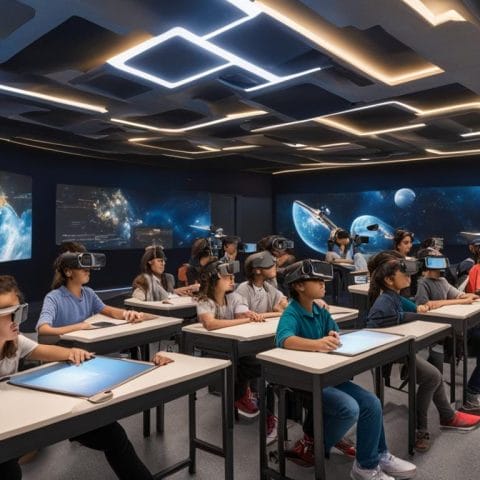The world of learning and development is on the cusp of a major transformation, driven by the rapid advancement of immersive technologies like virtual reality (VR) and augmented reality (AR). To explore the potential impact of these technologies on workplace learning, the Learning While Working podcast recently featured an insightful conversation with Danny Stefanic, a pioneer in the field of 3D technologies and founder of Hyperspace, our web-based 3D learning experience platform.
The Potential of AR and VR in Workplace Learning
Danny sees immense potential for AR and VR to revolutionize learning in the workplace. Some of the key application areas he highlights include:
– Hands-free learning on the job: AR enables workers to access information, instructions, and guidance while keeping their hands free to perform tasks. This is especially valuable for roles that involve operating machinery, performing installations or repairs, or navigating facilities.
– Practicing soft skills with virtual humans: The recent advancements in AI allow for the creation of highly realistic virtual characters that learners can interact with to practice soft skills like handling difficult customers or responding to objections. Immersive simulations provide a safe environment to build these skills.
– Experiential learning: VR enables learners to “learn by doing” in realistic virtual environments. Danny estimates that 80% of the value of immersive learning comes from the agency learners have to direct their own experience and see the outcomes change based on their choices and actions. This leads to better comprehension and retention compared to passive learning modalities.
While the immersive nature of VR adds an extra 20% of value, Danny emphasizes that simply putting traditional slideware content into a VR headset is not the right approach. To realize the full potential, learning designers need to shift to creating truly experiential simulations that allow learners to practice skills and apply knowledge.
## Overcoming Barriers to Adoption
Despite the exciting possibilities, Danny acknowledges there are still barriers that organizations face in adopting immersive learning technologies at scale:
– Hardware costs and logistics: High-end VR headsets like the Apple Vision Pro are still very expensive ($3500) and are more suitable for developers to create proofs-of-concept rather than for organization-wide rollouts. Shipping and managing a large volume of headsets also presents logistical challenges and costs.
– Limited battery life and wearability: Current VR headsets have short battery lives (around 1 hour) and can be uncomfortable or impractical for some users to wear for extended periods, especially if it interferes with hairstyles, makeup, or prescription glasses.
– IT security and device management: Deploying and managing VR applications within enterprise IT environments is complex, often requiring custom device management solutions that don’t integrate with existing systems. Getting new software and hardware approved is a “nightmare.”
– Achieving ROI at scale: With a limited number of VR headsets, it’s difficult to deliver immersive training to enough employees to justify the investment and development costs for custom content. Experiences need to reach the entire workforce to provide a meaningful return.
To overcome these challenges, Danny advocates for a “VR-ready” approach rather than a “VR-only” one. He recommends choosing development platforms that allow immersive experiences to be deployed across all devices (VR headsets, mobile, tablet, laptop, desktop) as standard web applications. This enables organizations to create 3D learning content once and make it accessible to all employees – a portion can explore it in VR for the full immersion, while the rest can still benefit from the interactive experience on traditional screens.
Danny sees web-based 3D as the future, as it aligns with enterprise systems, security models, and existing IT infrastructures in a way that game engine-based apps cannot. It also dramatically simplifies the process of deploying and updating immersive content compared to managing multiple native apps.
While web-based 3D may not yet match the visual fidelity of native apps, Danny believes the gap is closing quickly as new APIs and capabilities become available. More importantly, the benefits of the open web (easy integration, instant updates, access on any device, content security, etc.) will ultimately outweigh the marginal graphics differences for most enterprise use cases.
Getting Started with Immersive Learning
For L&D professionals looking to start experimenting with AR/VR, Danny offers this advice:
1. Start now. Begin exploring and familiarizing yourself with the tools and platforms that are available. Play around with several and assess them based on the criteria of being deployable across all devices, not just in VR.
2. Think “VR-ready”, not “VR-only.” Choose tools that allow you to create immersive content that can be experienced on the full range of employee devices to maximize your reach and ROI.
3. Prioritize no-code platforms. Pick tools that let you build immersive content using your existing instructional design skills (e.g. Storyline, Captivate) without needing to learn game engine programming or 3D design.
4. Acquire a VR headset to test and demo. Having first-hand experience with VR is essential to understanding its capabilities and conveying the possibilities to stakeholders.
5. Focus on creating experiential content. Resist the temptation to simply port existing slideware to VR. Embrace the opportunity to design truly interactive, choice-driven experiences that allow learners to practice skills in realistic contexts.
Danny’s company Hyperspace provides a platform that embodies many of these principles, enabling instructional designers to create interactive 3D scenarios with conversational AI characters, virtual environments, and multi-device deployments. He sees platforms like this as key to overcoming the barriers to entry and enabling organizations to start realizing the benefits of immersive learning today.
A Glimpse of the Future
Looking ahead, Danny predicts we are on the cusp of a major tipping point with immersive technologies. As AR/VR hardware continues to advance towards lightweight, glasses-based form factors, he believes 3D content and interfaces will become the new dominant computing paradigm, eventually replacing our 2D screens and mobile apps.
In the future, our primary interface to digital content and experiences will be the 3D world around us, coming full circle to a more natural way of interacting and learning. Danny refers to this transition as the “race to the face”, as tech giants compete to own the AR glasses that will provide our main portal to the metaverse.
For L&D, getting ahead of this curve by piloting immersive learning technologies today will be key to building the organizational capabilities needed to lead in a 3D-first world tomorrow. By embracing the unique affordances of experiential, embodied learning, organizations can transform employee skill development and unlock new levels of performance.
The road to widespread adoption of immersive learning is not without obstacles, but pioneers like Danny Stefanic are lighting the path forward. With the right tools, techniques, and mindset, forward-thinking L&D teams have an incredible opportunity to be at the forefront of this exciting new frontier.





